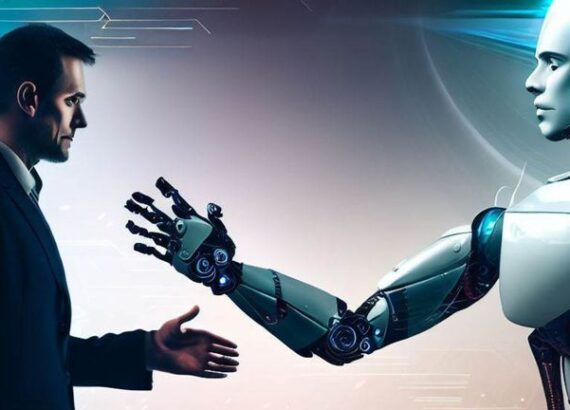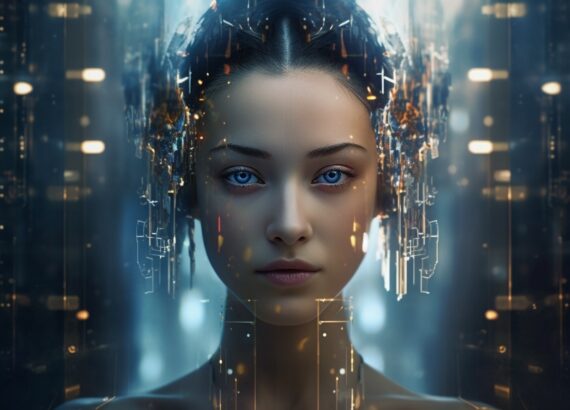What Is Generative AI? How ChatGPT works?
Generative AI, a subset of artificial intelligence, has emerged as a powerful technology capable of generating human-like content such as text, images, and music. Among the notable advancements in generative AI is ChatGPT, a language model developed by OpenAI. ChatGPT has gained immense popularity for its ability to hold conversations and generate coherent responses. This article aims to provide a comprehensive understanding of generative AI and delve into the inner workings of ChatGPT. We will explore its architecture, training process, capabilities, limitations, and real-world applications. Additionally, we will discuss the ethical considerations surrounding the use of ChatGPT and ponder the future implications of generative AI on various industries and society as a whole.
1. Introduction to Generative AI
What is Generative AI?
Generative AI is like having an AI-powered imagination. It refers to the ability of an artificial intelligence system to generate new content, such as text, images, or even music, that is original and creative. Instead of simply regurgitating existing data, generative AI has the capacity to come up with its own unique creations.
Importance and Applications of Generative AI
Generative AI holds immense importance in various fields. It enables us to automate content creation, making it a game-changer for industries like advertising, entertainment, and design. Additionally, it has promising applications in healthcare, where it can aid in drug discovery or generate synthetic data for research purposes. Generative AI also fuels innovations in virtual reality, gaming, and even storytelling.

2. Understanding the Basics of ChatGPT
Overview of ChatGPT
ChatGPT is a powerful language model developed by OpenAI. As the name suggests, it specializes in generating conversational responses. It can understand and provide coherent answers to prompts, engage in discussions, or even serve as a virtual assistant. ChatGPT builds on the success of earlier models like GPT-3, but with a focus on fine-tuning the system for chat-based interactions.
Key Features and Benefits of ChatGPT
ChatGPT offers a range of features that make it both impressive and practical. It has a natural language interface, allowing users to engage with it conversationally. The model is designed to offer helpful and informative responses, while also being mindful of human values. It adapts to specific instructions and can provide clarifications when needed. Furthermore, ChatGPT is built to be easy to use, making it accessible to both developers and non-technical users.
3. The Architecture and Components of ChatGPT
Transformer Model in ChatGPT
At the heart of ChatGPT lies the transformer architecture, a fundamental component in many advanced AI models. This architecture uses self-attention mechanisms to understand the relationships between words and generate contextually relevant responses. Transformers help the model capture long-range dependencies and enable it to generate coherent and meaningful text.
Encoder-Decoder Architecture
The encoder-decoder architecture is another crucial element of ChatGPT. The encoder processes the input prompt and encodes it into a representation that captures its meaning. The decoder then takes this representation and generates a response based on it. This two-step process allows ChatGPT to understand the context and generate appropriate replies.
Attention Mechanism in ChatGPT
The attention mechanism in ChatGPT helps the model focus on relevant parts of the input text. It allows the model to assign different weights to different words, focusing more on the important ones and paying less attention to irrelevant details. This attention mechanism enhances the model’s ability to understand and generate meaningful responses.

4. Training Process and Data Used in ChatGPT
Data Collection and Preprocessing
Training ChatGPT involves feeding it with vast amounts of text data from the internet. OpenAI uses a process known as web scraping to collect this data, which includes information from diverse sources to give the model a broad understanding of language. The collected data then undergoes preprocessing to remove irrelevant or biased content.
Training Techniques and Algorithms
To train ChatGPT, OpenAI uses a technique called unsupervised learning, where the model learns patterns and structures from the data without explicit labels. This is done through a process called “pre-training” using techniques like masked language modeling, where words are randomly masked and the model predicts the masked words based on context. Advanced algorithms and optimization techniques are employed to fine-tune the model’s performance.
Fine-tuning and Continuous Learning
After pre-training, ChatGPT goes through a fine-tuning process where it is trained on custom datasets created by OpenAI. This fine-tuning helps make the model more safe, useful, and aligned with human values. Continuous learning is an ongoing effort by OpenAI, where they refine the model based on user feedback and iteratively improve its capabilities over time.
5. Exploring the Capabilities and Limitations of ChatGPT
Natural Language Understanding (NLU)
ChatGPT, powered by generative AI, showcases impressive natural language understanding capabilities. It can comprehend and interpret human language to a significant extent. However, it’s important to note that its understanding is based on patterns it has learned from the data it has been trained on. While it can handle a wide range of inputs, there might still be instances where it struggles to grasp complex or ambiguous queries.
Contextual Understanding and Response Generation
One of the key strengths of ChatGPT is its ability to generate contextual responses. It can maintain a coherent conversation by considering the previous messages and context. This allows for meaningful and contextually appropriate replies. However, due to the limitations of the model, it sometimes produces responses that may sound plausible but are factually incorrect or nonsensical. So, it’s crucial to critically evaluate the output and not blindly trust every response.
Challenges and Shortcomings of ChatGPT
ChatGPT has its fair share of challenges and limitations. It tends to be sensitive to input phrasing, often providing different responses to slight rephrasing of the same question. Moreover, it can be excessively verbose and overuse certain phrases. It may also lack a consistent personality, as it can sometimes provide contradictory responses within the same conversation. Additionally, it is prone to making things up or providing answers that sound plausible but aren’t based on factual information.

6. Real-World Applications of Generative AI
Chatbots and Virtual Assistants
Generative AI, like ChatGPT, finds practical applications in chatbots and virtual assistants. These AI-powered entities can engage in conversations with users, answering queries, providing information, and even offering assistance in various tasks. They aim to simulate human-like conversations and improve user experiences across different industries.
Content Generation and Creative Writing
Generative AI models have revolutionized content generation and creative writing. They can assist writers by offering ideas, enhancing productivity, and creating drafts. They also find use in generating personalized recommendations, creative stories, and even poetry. However, while they can be helpful tools, relying solely on AI for content creation may compromise originality and human creativity.
Language Translation and Summarization
Generative AI has significantly impacted language translation and summarization tasks. AI models can now produce more accurate translations and automatic summaries of text. This technology allows for efficient communication across languages and streamlines the process of condensing information. However, it’s essential to be cautious of potential biases and errors in the generated translations and summaries.

7. Ethical Considerations in the Use of ChatGPT
Bias and Fairness
The use of ChatGPT, like any AI system, raises concerns about bias and fairness. These models learn from the data they are trained on, which can inadvertently include biases present in the training data. It is crucial to regularly evaluate and mitigate potential biases to ensure fair and equitable outcomes when using ChatGPT.
Privacy and Data Security
Privacy and data security are important considerations when utilizing ChatGPT. Interacting with AI systems involves sharing information, and it’s essential to handle user data responsibly. Safeguarding personal data, ensuring data encryption, and being transparent about data usage are crucial elements in maintaining user trust.
Responsible Use of ChatGPT
While ChatGPT can be a powerful tool, responsible use is paramount. It should not be used to spread misinformation, engage in harmful activities, or deceive others. Users and developers have a responsibility to ensure that the technology is used ethically and does not harm individuals or society as a whole.

8. Future Developments and Implications of Generative AI
Advancements in Generative AI Research
Generative AI is an evolving field with ongoing research and advancements. Researchers work towards improving the capabilities of models like ChatGPT, addressing limitations, and enhancing the understanding of human language. This continuous development will lead to more sophisticated and reliable generative AI systems in the future.
Impact on Industries and Society
The impact of generative AI on industries and society is far-reaching. It has the potential to revolutionize customer service, content creation, and communication. However, it may also disrupt job markets and require ethical considerations to maintain human control and accountability over AI systems.
Potential Ethical and Legal Challenges
As generative AI continues to advance, it brings forth ethical and legal challenges that need to be addressed. These include issues such as accountability for AI-generated content, the potential for misuse or abuse of technology, and the implications of AI-generated information in legal proceedings. Striking a balance between innovation and responsible regulation will be crucial in navigating these challenges.

Conclusion
Generative AI, exemplified by ChatGPT, represents a significant milestone in the field of artificial intelligence. With its ability to generate human-like responses and carry out meaningful conversations, it opens up exciting possibilities for chatbots, content generation, language translation, and more. However, it is crucial to address the ethical considerations surrounding its use, such as bias and privacy concerns. As generative AI continues to evolve, it is important to navigate these challenges responsibly and ensure that its potential benefits are harnessed for the betterment of society. With ongoing advancements and research, the future of generative AI holds immense promise, but we must proceed with caution and foresight.
FAQ
1. How does ChatGPT generate responses?
ChatGPT generates responses by utilizing a Transformer model, which is a deep learning architecture that uses self-attention mechanisms to process and understand input text. It learns patterns and relationships in the training data, enabling it to generate coherent and contextually relevant responses based on the input it receives.
2. Can ChatGPT understand and respond accurately to any input?
While ChatGPT can provide impressive responses, it has limitations. It largely relies on patterns it has learned during training and may produce incorrect or nonsensical answers. It may also struggle with understanding complex queries or handling ambiguity. OpenAI continues to work on improving these limitations and encourages user feedback to enhance its performance.
3. How can generative AI like ChatGPT be ethically used?
Ethical considerations are crucial when using generative AI like ChatGPT. It is important to ensure that bias is minimized in the training data to avoid generating biased or discriminatory responses. Privacy and data security must also be prioritized when handling user interactions. Responsible use of generative AI involves transparency, clear communication of its limitations to users, and being cautious of potential misuse, such as the creation of deepfakes or spreading misinformation.
4. What are the future implications of generative AI?
The future implications of generative AI are vast. It has the potential to revolutionize various industries, such as customer service, content creation, and language translation. However, it also raises concerns about job displacement and the spread of misinformation. As generative AI continues to advance, it is crucial to carefully consider its ethical, legal, and societal impacts, while fostering ongoing research and collaboration to harness its benefits responsibly.














